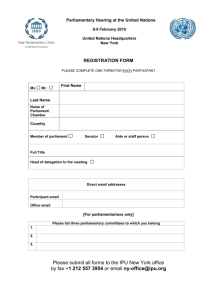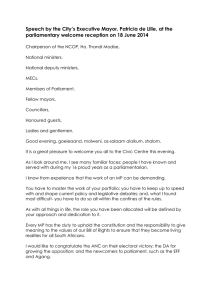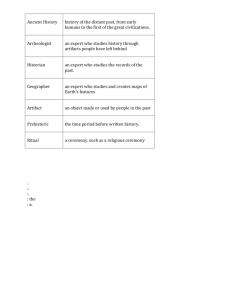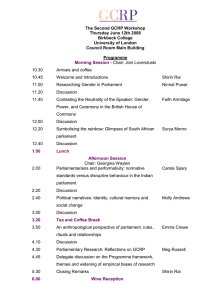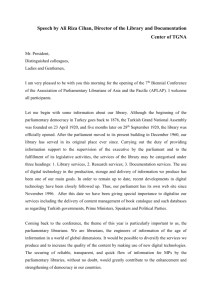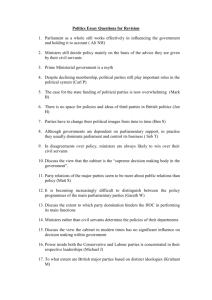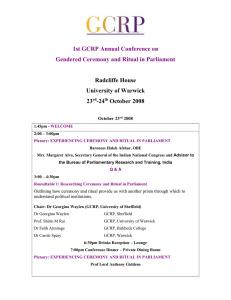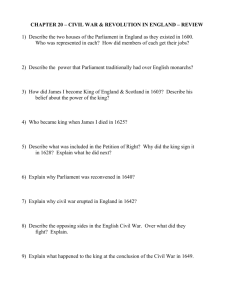ANNEXES Annex 1 GCRP List of Advisory Board Members and Programme... 11 Annex 2 Research Designs - The Indian Parliament
advertisement
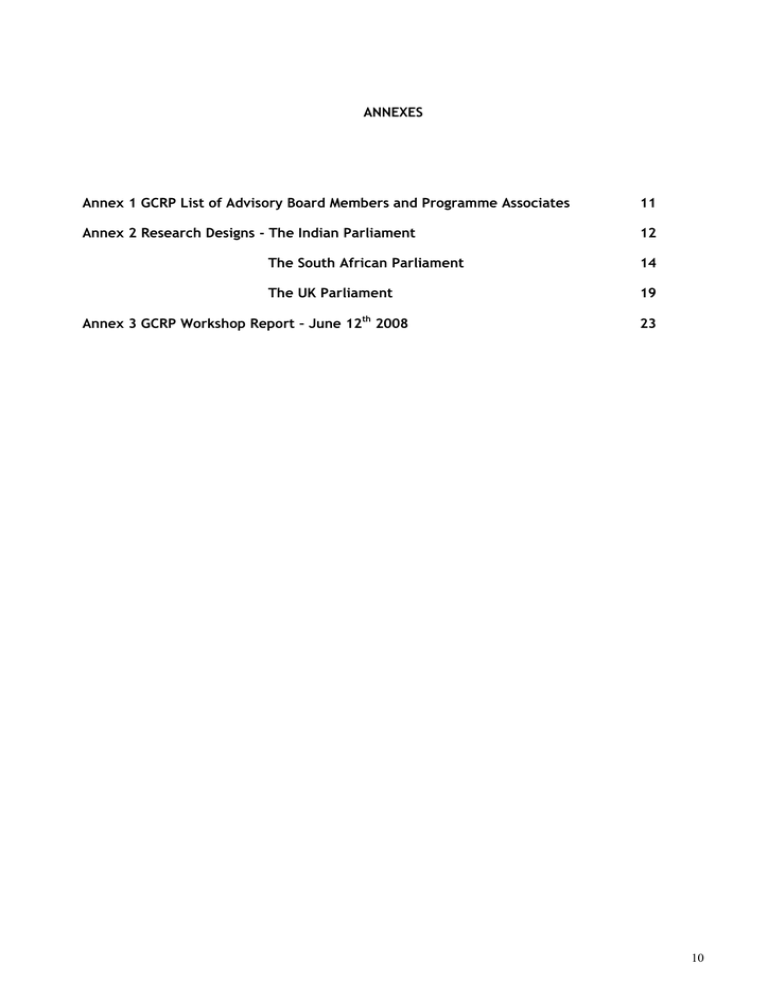
ANNEXES Annex 1 GCRP List of Advisory Board Members and Programme Associates 11 Annex 2 Research Designs - The Indian Parliament 12 The South African Parliament 14 The UK Parliament 19 Annex 3 GCRP Workshop Report – June 12th 2008 23 10 1 Annex 1 GCRP Advisory Board Members The Rt. Hon. Mrs. Margaret Alva –The Indian National Congress and the Bureau of Parliamentary Research and Training, India Dr. Molly Andrews – University of East London Dr. Emma Crewe- ChildHope Ms. Oonagh Gay– House of Commons, Westminster Professor Niraja Gopal Jayal –Jawaharlal University Professor Shireen Hassim – University of Witwatersrand GCRP Programme Associates Dr. Christine Battersby– University of Warwick Professor Karen Celis – University College Ghent Professor Diana Coole – Birkbeck College, University of London Professor Philip Cowley – University of Nottingham Professor Susan Franceschet – University of Calgary Dr. Fiona Mackay- University of Edinburgh Professor Anne Phillips – London Professor The Lord Philip Norton of Louth – University of Hull Dr. Oliver Philips – University of Westminster Dr. Nirmal Puwar–Goldsmiths, University of London Professor Vicky Randall – University of Essex Dr. Meg Russell – University College London Bill Schwarz – Queen Mary, University of London Professor Judith Squires - University of Bristol Professor Sophie Watson – Open University 11 1 Annex 2 RESEARCH DESIGN –THE INDIAN PARLIAMENT RESEARCH QUESTION RESEARCH METHOD DATA SOURCES OUTCOME What do we understand by ceremony and ritual and what does the study of these tell us about the gendered nature of the Indian parliament and its practices? What is the significance of the study of British parliamentary ceremony and ritual for understanding post-colonial Indian parliamentary politics? Secondary literature review Secondary literature on ceremony a nd ri tua l, g en d er a n d representation, political theory, and political anthropology. Documentary material on the 1919 Montagu-Chelmsford reforms and the 1935 Government of India Act Secondary literature on the colonial period. Constituent Assembly Debates Nehru’s writings and speeches Secondary literature on the nationalist movement and Independence A detailed theoretical understanding of the key analytical concepts employed in the research project as well as the potential for their application to the empirical case of the Indian Parliament. A detailed understanding and appreciation of the historical context of the emergence of the Indian Parliament tracing from the British colonial period, in terms of its impact on the institutional design and creation of the Indian Parliament. A detailed understanding of the historical specificity of the establishment of parliament, the myriad ways in which the postcolonial context shaped embedded norms of parliamentary institutions through ceremony and ritual, and the extent to which these inform current rituals and ceremony and embody nationalist, secularist, modernist and developmental aspirations. An understanding of the way in which the concept of ‘space’ might inform an understanding of ceremony and ritual in parliament. Archival research Secondary literature How do rituals and ceremony reflect the ideals of the postcolonial state – modernity, nationalism, secularism, development? Archival research Secondary literature How are ceremony and ritual played out spatially? To what extent is parliamentary ceremony and ritual embodied in and differentiated through space? Visual ethnography (photographs, vi d e o) Semi-structured interviews Documentary analysis How do ceremony and ritual affect particular identities in post-colonial India? And how do MPs with different identities negotiate ceremony and ritual in the Indian parliament? Semi-structured interviews Observation Documentary analysis MembersofParliament(including c omm it te e me m b ers ) Parliamentary staff Parliament Library Material of the Parliamentary Bureau of Training Architectural drawings of Parliament buildings Interviews with Members of Parliament including members of the Inter-Parliamentary Group Parliamentary staff including Parliamentary Bureau of Training Observation of parliamentary training Documentary analysis of parliamentary procedural documentation such as the An understanding of the ways in which parliamentary rituals and ceremonies shape and discipline the identities of parliamentary subjects, the extent to which parliament ceremony and ritual privilege some subject identities and exclude others, and how some challenge dominant ceremonies and rituals. What is the potential for reform towards more inclusive democratic processes? 12 RESEARCH QUESTION How do ceremony and ritual help us understand the importance of performing roles within a political space, in an historical context and mediated through the lens of specific identities? What part do ceremony and ritual play in legitimising Parliament as a democratic institution of governance? Comparing Gendered Ceremony and Ritual in Parliaments RESEARCH METHOD Semi-structured interviews Visual ethnography: observation, photography Using audiovisual/visual material as prompts in interviews Semi-structured interviews Documentary analysis Surveys Comparative analysis DATA SOURCES Handbook for Members of the Lok Sabha and Rajya Sabha, audiovisual material from the Parliamentary Bureau of Training. Analysis of Lok Sabha and Rajya Sabha debates and questions Interviews with Members of Parliament Analysis of audio-visual material from Lok Sabha TV Analysis of Presidential Address to Parliament and other ceremonies Photographs taken during observation (outside the Chambers) Public opinion surveys including those already published (e.g. CSDS) Interviews: journalists, citizens Lok Sabha TV programme on visitor reactions to Parliament Project findings from the UK and South African cases, as well as the Indian case. OUTCOME A detailed understanding of how ceremony and ritual are embodied through performance, how performance signifies ceremony and ritual, and the effect performance has on the disciplining function of ceremony and ritual but also the negotiating and subverting potential of parliamentary subjects. An understanding of how ceremony and ritual function to legitimise Parliament as an institution of representative democracy but also of governance, and whether this has changed over time due to external and internal changes. A broader understanding of case-specific and more generalised observations of ceremony and ritual in the three Parliaments under study and what these observations signify in a comparative context. 13 RESEARCH DESIGN –THE SOUTH AFRICAN PARLIAMENT Stage 1 Stage 1. Themes, 2. Concepts and 3. Approaches 1. Nature of Parliament Functions: Representation, Legitimation, Scrutiny, Accountability Setting: Geographical – Building; Working Methods Identify Define Theoretical exegesis Elucidate Theorise Identify classic, official, biographic and secondary sources, data bases, public relations activities such as tours and publications – how does parliament present itself? Establish timeline of Development of Parliament in terms of key themes, starting with classic sources, official accounts. Key moments of transformation: Convention Gender: Masculinity Femininity Race Identity 3. Institutionalism Discourse Behaviour Gendered Ceremony and Ritual Define concepts, describe themes, describe and summarise appropriate theories. Political– Constitutional Centrality Historic– Colonial/moments of transition Animation and working: roles of parties 2. Ceremony Ritual Performance Procedure Stage 2 DESIGN Research Activities: Ground clearing and literature review. Identify sources and create bibliography. Arguments and hypotheses 1948; 1994, changes post1994 Describe spatial contexts: National Assembly, Provinces, Committees. Describe culture (s) MPs, House officials and staff, press, include language, dress codes/ costumes, speech and discourse requirements, behavioural hierarchies. Establish ceremonies, rituals, conventions and procedures both in key areas of parliamentary activity such as debates and also in daily rituals such as opening ceremony, speaker process etc. Africanization of symbols etc? Rejection of things associated with Westminster model post 1994? Ways in which the Westminster model has been continued – the Westminsterisation of previously oppositional parties, groups, people? (Comparison with the Supreme Court as a new institution with a more African sensibility and notions of justice?) Indicative Sources: parliament website; IDASA and Parliamentary Monitoring Group websites, auto/biographies/memoirs/existing interview data? Output: Literature review on methods and approaches. Research question: What are the formal and informal rules and norms of the parliament and how do they intersect? How do they vary by performer? How are they expressed and transmitted? How do they vary by different party/are negotiated by the different party members? Who is excluded/excludes themselves and what part do norms, rituals etc play in this? Activities: Identify gaps in data and conceptual limitations in existing C&R theoretical work. 14 Stage Stage 3: FIELDWORK (four components 1. Performance and behaviour Working Methods Operationalise Research Research Review and alter if necessary the research aims and questions outlined in the initial proposal. Initial work redeveloping classification schemes of ceremony, ritual etc. using stage 1. Outcomes: key areas of activity for research identified; research design is developed comparing behaviour across sex, race, party and time in key representative activities, core parliamentary ceremonies and daily rituals (see plans for fieldwork). Pre and post 1994 (and 1948) Research questions: How does ritual affect: parliamentary working; the relationships (amongst parliamentarians and between civil society groups and M Ps?) Observation, interviews, process tracing, data analysis, archival, media and secondary sources. Activities: I.New empirical research: Establish Functions and activities such as Parliamentary activities of women and men at all levels of parliamentary hierarchies, by cohort. Year of first election to HC. Analyze particular parliamentary debates (set pieces and everyday); discussions in Select Committees and Standing Committees; other parliamentary activities. Consider discourse analysis following key debate of one or more types through legislative process. (possible comparative project across three Parliaments). Analyse ways in which issues may be framed as women’s issues and marginalised – or mainstreamed and where the latter, changes in overall culture Describe and analyze interactions in cross-party groups as well as ANC; other party groups established concerning gender. Analysis to look, for example, of cases of women MPs supporting embattled women MPs in Chamber (Routledge-Madlala?) Address discrepancies between different types of symbol, ritual within parliament, eg possible divergences between website representations and the norms within parliamentary activities Describe and analyse How certain policy or political affiliations affect the types of ritual/symbol/norm presented by particular actors within parliaments (e.g do women MPs feel a need to dress more conservatively when pursuing more radical stances?) Describe and analyse What the role of ritual and ceremony in the identity changes of female and male MPs, on entry into parliament, and later? What about MPs who leave? And those who are assimilated? Those who remain for a time but do not fit well within the institution? 15 Stage Working Methods Stage 3: FIELDWORK (cont.) Research Describe and analyze reactions of different groups of MPs and spectators to South African parliament. Use biographic and interview sources on MPs, survey data on mass public (spectators) Analyze parliamentary sketches for representations of MPs (by sex, race, other social characteristics); supplement with elite interviews with media informants. (possible comparative project?) Analyze archives for constitutional negotiations around choice of symbols etc of new constitutional set up post 1994 (flag, anthem etc). Activities II. Reanalysis of secondary sources: Comparisons of writings about different types of MPs (by different generations of writers) on responses to parliament Eg. On women – Britton, Geisler; (using, in addition, auto/biographies – Pregs Govender, Winnie Mandela, Helen Suzman (pre 94). Auto/biographies of Thabo Mbeki, Nelson Mandela, Zuma etc – look in particular on how gender dealt with Research questions: What are the dominant forms of the behaviour of elected representatives? How do parliamentary rituals and ceremonies discipline MPs? How do dominant notions of appropriate behaviour affect the representativeness of legislatures? 2. Space Observation, elite and expert interviews, archival, biographic. ‘We shape our buildings then our buildings shape us’(Churchill) Activities: Analyse MPs/Parliamentary workers/ public perceptions/experiences of architecture/ atmosphere – masculinized/classed/raced Chambers; Other spaces (comparison with new supreme court) Research questions How is parliament ‘experienced’, ‘perceived’,‘ lived’ (‘challenged’, transformed’, ‘resisted’)by those who inhabit it? Does this differ for different MPs? by role? by different spaces in Parliament? What about civil society representatives who engage with parliamentary spaces? 16 Stage 4 COMPARISON Stage 3. Spectacle: Costume, Speech, Communications Working Methods Observation, elite int er v i ews a n d me d ia / v is ua l representation analysis, Research Activities: Analysis of Parliamentary dress codes and costumes (formal and informal)– MPs, staff (all levels) Africanization post 1994? Presentation of the self as ‘work’ and gendered/raced etc differences re this? Analysis of costume/speech of everyday of grand ceremonies (eg, analysis of state opening, maiden and/or resignation speeches; question time) Analysis of media coverage (eg, of M Ps’ dress/style of interaction; men and women’s performance on floor of chamber–what is perceived to be successful, and how is this gendered?) Analysis of visual representations of MPs and others who inhabit Parliament, artwork of parliament Research questions: How do those who inhabit Parliament present themselves visually and in speech; and how are they visually represented by others? Does this differ by sex, race and other characteristics? 4. Representation and Inclusion Elite interviews, process tracing Activities Analysis of MPs’ interaction with public/civil society groups): based on interviews with civil society groups (concerning just gender? HIV? Children’s issues?) and MPs together with analysis of Hansard; other parliamentary behavior (where evidence of acting for civil society group); secondary analysis of public perceptions of, and reactions to MPs, by sub groups using existing survey data?, (this could be comparative project) Consider by category of MP – men, women, race, party, cohort Research questions: What are the relationships between MPs, those they claim to represent, and civil society groups which share their social identity? how are such identities ‘acted upon’/ ‘played out’ by the MPs and civil society groups? (ie, how is the relationship between descriptive and substantive representation negotiated in parliament?) Bring compa rative dimensions of project together Research Questions: How do these vary across types of political system? Can a focus on ceremony and ritual (in parliaments) enhance feminist institutionalist analyses (of parliaments) (GW) 17 Stage Stage 4 COMPARISON (cont.) Working Methods Research What is the relationship between a disjuncture or newness of institutions and the nature of ceremony and ritual? Can this add to our understanding of institutions and institutional change? (GW) What kind of comparative frameworks can be used to analyse gendered ceremony and ritual in the three parliaments. How can this contribute to a comparative politics of gender/gendered comparative politics? (GW) How can the concepts associated with intersectionality enhance the understanding of gendered ritual and ceremony in parliament? (SM) What forms of Southern gender analysis (postcolonial feminisms, womanisms) are useful in the parliamentary context and how does analysis of gendered ritual in Parliament extend feminists and gender analysis? (SM) Comparison of one/more policy areas eg domestic violence, same sex partnerships? Stage 5 CONCLUDE To what extent and in what ways are ceremony and rituals gendered, racialised and sexualized? 18 RESEARCH DESIGN - THE UK PARLIAMENT Stage 1 Stage 1. Themes, 2. Concepts and 3. Approaches 1. Nature of Parliament Functions: Representation, Legitimation, Scrutiny, Accountability Setting: Geographical – Building; Working methods Identify Define Theoretical exegesis Elucidate Theorise Performance Procedure Convention Gender Race Identity 3. Institutionalism Discourse Behaviour Gendered Ceremony and Ritual Define concepts, describe themes, describe and summarise appropriate theories. Political– Constitutional Centrality Historic– Colonial Animation and working: roles of parties 2. Ceremony Ritual Stage 2 DESIGN Research Activities: Ground clearing and literature review. Identify sources and create bibliography. Arguments and hypotheses Operationalise Research Identify classic, official, biographic and secondary sources, data bases, public relations activities such as tours and publications – how does parliament present itself? Establish timeline of Development of Parliament in terms of key themes, starting with classic sources, official accounts. Describe spatial contexts: Commons, Lords, Chamber, Committees, Portcullis House, Westminster Hall Describe culture (s) MPs, House officials and staff, press, include language, dress codes/ costumes, speech and discourse requirements, behavioural hierarchies Establish ceremonies, rituals, conventions and procedures both in key areas of parliamentary activity such as debates and also in daily rituals such as opening ceremony, speaker process etc.. Indicative Sources: Eskine May, H of C factsheets, Rogers and Walters; auto/biographies/memoirs/existing interview data (BRS; Sones et al; Michael Rush’s work; Hansard Society Reports). Output: Literature review on methods and approaches Research question: What are the formal and informal rules and norms of the parliament and how do they intersect? How do they vary by performer? How are they expressed and transmitted? Activities: Identify gaps in data and conceptual limitations in existing C&R theoretical work. Review and alter if necessary the research aims and questions outlined in the initial proposal. Develop classification schemes of ceremony etc. using stage 1. Outcomes: key areas of activity for research identified; research design is developed comparing behaviour across sex, race, party and time in key representative activities, core parliamentary ceremonies and daily rituals (see 19 Stage Stage 3: FIELDWORK (four components) 1. Performance and behaviour Working methods Observation, interviews, process tracing, data analysis, archival, media and secondary sources. Research plans for fieldwork) Research questions: How does ritual affect: parliamentary working; the relationships (amongst parliamentarians and between civil society groups and M Ps?) Activities: I.New empirical research: Establish Functions and activities such as Parliamentary activities of women, BME, v white, male at all levels of parliamentary hierarchies, by cohort. Year of first election to HC. Analyze particular parliamentary debates (set pieces and everyday); compare with debates in Westminster Hall, discussions in Select Committees and Standing Committees; other parliamentary activities. Consider discourse analysis following key debate of one or more types through legislative process. (possible comparative project across three Parliaments) Describe and analyze interactions in Cross-party groups including Parliamentary Labour Party Women’s Group; other party groups established to act for women/other marginalized groups. Analysis to look, for example, of cases of women MPs supporting embattled women MPs in Chamber Describe and analyze reactions of different groups of MPs and spectators to Westminster parliament e.g. Irish, Welsh, Scots, Ethnic, Women. Use biographic and interview sources on MPs, survey data on mass public (spectators) Analyze parliamentary sketches for representations of MPs (by sex, race, other social characteristics); supplement with elite interviews with media informants. (possible comparative project?) Activities II. Reanalysis of secondary sources: Comparisons of writings about different types of MPs (by different generations of writers) on responses to parliament Eg. On women –Vallance, Abdela, MacDougall, Childs, Sones, Melanie Phillips; on Welsh, Scottish and Northern Irish MPs (using, in addition, auto/biographies). Compare with other studies of MPs, such as Searing. Research questions: What are the dominant forms of the behaviour of elected representatives? How do parliamentary rituals and ceremonies discipline MPs? How do dominant notions of appropriate behaviour affect the representativeness of legislatures? 20 Stage 2. Space Working methods Observation, elite and expert interviews, archival, biographic. Research ‘We shape our buildings then our buildings shape us’(Churchill) Activities: Analyse MPs/Parliamentary workers/ public perceptions/experiences of architecture/ atmosphere – public school/mascu l in ized/classed/raced Westminster Hall; H of C Chamber; Portcullis House Other spaces Research questions How is parliament ‘experienced’, ‘perceived’,’ lived’ (‘challenged’, transformed’, ‘resisted’) by those who inhabit it? Does this differ for different MPs? by role? by different spaces in the Palace of Westminster? 3. Spectacle: Costume, Speech, Communications Observation, elite interviews and media/visual representation analysis, Activities: Analysis of Parliamentary dress codes and costumes (formal and informal)– MPs, staff (all levels, Black Rod to cleaners) Analysis of costume/speech of everyday cf grand ceremonies (eg, analysis of maiden and/or resignation speeches; question time; PMQs) Analysis of media coverage (eg, of MPs’ dress/style of interaction - cleavage debate - Smith and May of autumn 2007; women MPs inability to ‘perform’ on floor of chamber) Analysis of visual representations of MPs and others who inhabit Parliament, eg, photographic exhibition summer 2007 on those work at Parliament; Portraits of MPs in House and Portcullis House Research questions: How do those who inhabit Parliament present themselves visually and in speech; and how are they visually represented by others? Does this differ by sex, race and other characteristics? 21 Stage 4. Representation and Inclusion Stage 4 COMPARISON Stage 5 CONCLUDE Bring comparative dimensions of project together Working methods Elite interviews, process tracing Research Activities Analysis of p MPs’ interaction with public/civil society groups): based on interviews with civil society groups and MPs together with analysis of Hansard; other parliamentary behavior (where evidence of acting for civil society group); secondary analysis of public perceptions of, and reactions to MPs, by sub groups using existing survey data, such as BES (this could be comparative project) Consider by category of MP – women, BME, party, cohort, country background (Scots, Welsh, N. Irish) Research questions: What are the relationships between MPs, those they claim to represent, and civil society groups which share their social identity? how are such identities ‘acted upon’/ ‘played out’ by the MPs and civil society groups? (ie, how is the relationship between descriptive and substantive representation negotiated in parliament?) How do these vary across types of political system? To what extent and in what ways are ceremony and rituals gendered, racialised and sexualized? 22 Annex 3 GCRP Workshop Report Date: June 12th 2008 Venue: Birkbeck College, University of London 23 Table of Contents Report of the First GCRP Workshop Shirin M. Rai 3 Workshop Delegate List 5 Workshop Programme 6 Challenging the Neutrality of the Speaker: Gender, Power, and Ceremony in the British House of Commons Faith Armitage 7 Symbolising the rainbow: Glimpses of south African Parliament Surya Monro 10 Parliamentarians and Performativity: Disrupting rituals of parliamentary Debate in the Indian parliament CaroleSpary 14 Political Narratives: Identity, Cultural memory and Social Change Molly Andrews 16 ‘The Wonderful World of the House of Lords’ An anthropological perspective: rules, rituals and relationships Emma Crewe 18 24 REPORT OF THE FIRST GCRP WORKSHOP The first workshop of GCRP was held on the 12th June at Birkbeck College, University of London. Other than the Programme members, some Advisory Board members, Programme Associates as well as other academics and PhD students attended (see list of attendees). Six papers were presented (see conference programme) and there was productive and robust discussion of each of the papers as well as of the work of GCRP Programme. The main themes that emerged from these papers and discussion were the following: Tradition and modernity– new and old rituals and what do these tell us about parliamentary institutions Everyday politics – the importance of exploring these as ceremonials are more staged and less open to interpretation by both MPs (participants) as well as citizens (audience) Temporality- emphasis on the historical evolution and development of institutions, together with a spatial analysis Intersectionality–importance of class, caste and race together with gender when analysing ceremony and ritual Some key suggestions made by participants were Both rituals as well as counter-rituals need to be analysed. We also need to investigate what ceremonies and rituals do, not only what they mean as they mean different things to different people, so to try to narrow them down to definitive meanings can be reductive. More attention needs to be paid to how political parties interface institutions and identity Analysis of parliaments’ interface with media –their insularity as institutions as contrasted with how the outer world perceives them Need to assess how changing memberships of institutions over historical time changes ceremony and ritual Practical methodological advice was given regarding the sensitivities surrounding interview subjects and interviewing, specifically with reference to asking directly about processes and practices of inclusion and exclusion and not over-determining interviewees' responses. For example, examining the norms and terms of inclusion may be more revealing of processes of exclusion and marginalisation than asking directly about the latter. Key challenges outlined in the discussion include the following: Comparative work– care needs to be taken that transference isn’t equated with comparison; systematic comparison means that common questions need to be put together before field work starts; recognise the historical specificity of each empirical case and therefore recognise the need for caution when applying shared theoretical and conceptual frameworks to different empirical cases. Dis-covering and analysing both visible and invisible effects of power within parliamentary ceremonies and rituals and the boundaries of what we define as 'ritual' in terms of the formal and the informal (rules, norms, practices etc) and 25 their interplay - theoretical development needed on the power-laden relationship between rituals and the identities of participants and audience. This includes the extent to which actors can use rituals for their own instrumental purposes as opposed to the extent to which rituals constitute and discipline the identity of its participants and audience. Analysing hybridity and embedding ceremony and ritual in a political science framework while at the same time being open to interdisciplinarity Consideration of how our own situatedness as researchers across the three cases plays a part in determining our relationship to our research subjects in the course of our research. Overall, the GCRP Programme members found this an extremely rewarding session – intensive but highly productive. The presentations by the postdoctoral fellows were well received and the PhD students were able to participate in the discussions. We were able to present and discuss, for the first time, preliminary papers and ideas and found the response of others both engaged and positive. Participants felt that the issues highlighted by the Programme – representation, space (and time), performativity (and performance) and legitimacy – were important in understanding parliaments. They also encouraged us to examine these in a comparative context, although pointing to the challenges such a comparison might entail. Most importantly, it was felt that the group of people involved in the Programme were able to work very well together providing stability and synergies that would be productive. The next event is the conference at the University of Warwick on the 23-24th October 2008. Professor Shirin Rai Director – GCRP Co-Directors: Sarah Childs – University of Bristol Joni Lovenduski – Birkbeck College, University of London Georgina Waylen – University of Sheffield 26 Name B a i rave e Balasubramaniam GCRP Carole Spary GCRP Christine Battersby GCRP Workshop Delegate List June 12th 2008 Birkbeck College, University of London Institution Email Contact University of Warwick b.balasubramaniam(warwick.ac.uk University of Warwick c.spary(warwick.ac.uk University of Warwick C.Battersby(warwick.ac.uk University of London, Birkbeck ChildHope d.coole(bbk.ac.uk University of London, Birkbeck University of Sheffield f.armitage(bbk.ac.uk University of London, Birkbeck UniversityCollege Ghent University College London University of East London Goldsmiths University of London University of Leeds j.lovenduski(bbk.ac.uk University of Nottingham HouseofCommons Library University of Bristol philip.cowley(nottingham.ac.uk University of Bristol s.childs(bristol.ac.uk University of Warwick s.rai(warwick.ac.uk Open University s.watson(open.ac.uk Surya Monro GCRP Ted Svensson University of Sheffield s.monro(sheffield.ac.uk University of Warwick t.svensson(warwick.ac.uk Victoria Hasson GCRP University of Sheffield victoriahasson(googlemail.com Diana Coole Emma Crewe Faith Armitage GCRP GeorginaWaylen GCRP Joni Lovenduski GCRP Karen Celis Meg Russell Molly Andrews Nirmal Puwar Oliver Phillips Philip Cowley Richard Kelly Rosa Malley GCRP Sarah Childs GCRP Shirin Rai GCRP Sophie Watson ecrewe(childhope.org g.waylen(warwick.ac.uk karen.celis(hogent.be meg.russell(ucl.ac.uk m.andrews(uel.ac.uk n.puwar(gold.ac.uk o.phillips(leeds.ac.uk kellyrj(parliament.uk rm7346(bristol.ac.uk 27 The Second GCRP Workshop Thursday June 12th 2008 Birkbeck College University of London Council Room Main Building Programme Morning Session - Chair: Joni Lovenduski 10.30 Arrivals and coffee 10.45 Welcome and Introductions Shirin Rai 11.00 Researching Gender in Parliament Nirmal Puwar 11.20 Discussion 11.40 Contesting the Neutrality of the Speaker: Gender, Power, and Faith Armitage Ceremony in the British House of Commons 12.00 Discussion 12.20 Symbolising the rainbow: Glimpses of South African Surya Monro parliament 12.40 Discussion 1.00 Lunch 2.00 Afternoon Session Chair: Georgina Waylen Parliamentarians and performativity: normative standards Carole Spary versus disruptive behaviour in the Indian parliament 2.20 Discussion 2.40 Political narratives: Identity, cultural memory and Molly Andrews social change 3.00 Discussion 3.20 Tea and Coffee Break 3.50 An anthropological perspective of parliament: rules, rituals Emma Crewe and relationships 4.10 Discussion 4.30 Parliamentary Research: Reflections on GCRP 4.45 Delegate discussion on the Programme framework, themes Meg Russell and widening of empirical bases of research 5.30 6.00 Closing Remarks Shirin Rai Wine Reception 28 Faith Armitage – GCRP Postdoctoral Fellow Challenging the Neutrality of the Speaker: Gender, Power, and Ceremony in the British House of Commons Outline 1. Brief history of the office of Speaker; esp. emergence of neutrality norm 2. Speaker’s ceremonies – do they matter? 3. Is the Speakership gender neutral? Faith Armitage 12 June 2008 Birkbeck – GCRP workshop •Traditional gender binary story •Subversive story Medieval Speakers Peter de Montfort – 1258 Sir Peter de la Mare – 1376 Sir Thomas Hungerford – 1377 Chapter House, Westminster Abbey The ‘neutral model’ of the Speaker emerges 2. Speaker’s ceremonial duties – do they matter? Speaker Arthur Onslow, 1728 - 1761 James Abercromby, 1835-39 (top); Charles Shaw-Lefevre, 1839-57 Martin being ‘dragged’ to the Chair (below); the daily Procession “The Commons go to the House of Lords, where they are directed to elect a Speaker. Having gone back to their own House and done so, the Commons return to the Lords the next day, where the Queen’s approbation of the Speaker-Elect is signified. (These ancient usages reflect a medieval relationship with the Sovereign; but should it ever happen that the Commons were unwilling to go to the Lords on either occasion, it would be difficult to imagine that their choice of a Speaker could be challenged as being somehow illegal or ineffective.)” Rogers and Walters,137 29 Black Rod Prime Minister Benjamin Disraeli The ceremonies “reflect a medieval relationship with the Sovereign; but should it ever happen that the Commons were unwilling to go to the Lords on either occasion, it would be difficult to imagine that their choice of a Speaker could be challenged as being somehow illegal or ineffective.” Rogers and Walters,137 3. Speaker as gender neutral? 30 Speakers Morrison and Boothroyd Sexual double standards apply Speaker Martin being assisted by his trainbearer 31 Surya Monro – GCRP Postdoctoral Fellow Why ritual and ceremony in South African Parliament? • Political scientists focus on representation and accountability • But, parliamentary culture forms the means by which politics are constituted and signified • There is a research gap concerning ritual and ceremony in South African parliament • The paper aims to provide a foundation for addressing the hypothesis that: representative institutions operate through evolving repertoires of ritual and ceremony which control the members (performance) and signify their function to the public (audience) Symbolising the Rainbow: Glimpses of South African Parliament Surya Monro, University of Sheffield 24/06/2008 © The University of Sheffield Structure Definitions of ritual and ceremony • Definitions of ceremony and ritual (CR) • The historical development of ceremony and ritual in South Afric an Parliament • Classical sociological definitions: Weber, Tylor • Lukes: ‘rule-governed activity of a symbolic character which draws the attention of its participants to objects of thought and feeling which they hold to be of special significance’ (1977:54). • Muller: parliamentary rituals as ‘procedures, or ways of organising social behaviour, that are necessary for conducting parliamentary business as much as they convey meaning both to parliamentary insiders and to the public outside the institution’ (2006:185). • Early unified South African and apartheid -era • Transitional and post-transition • Tentative conclusions • Caveats: • Includes attention to ethnicity throughout; gender to be dealt w ith in subsequent paper. • Danger of reifying parliamentary institutions via focus on ritua l and ceremony • Wider context/limitations of parliament • Does not deal with interpretations of CR and analysis of power 24/06/2008 © The University of Sheffield 24/06/2008 © The University of Sheffield What questions emerge from the literature? • What ceremonies and rituals – and related cultural forms – are found in South African parliament? • • • • • Overarching norms Spatial aspects Procedural norms/rituals Norms regarding interaction Other aspects including dress and symbols • How have ritual and ceremony within SA parliament changed over time? • What are the key cultural influences on the development of ritual and ceremony in SA parliament? 24/06/2008 © The University of Sheffield Pre-transition SA parliament: Overarching structures/norms • • • • Union of South Africa established in 1910 Most of the traditions and procedures originated in British parl iament This trend continued with the institutionalisation of apartheid in 1948parliament based on extreme ethnic divisions – although the tricameral parliament in 1983 opened up some (very) limited space for multi culturalism The reinscription of white colonial/postcolonial norms continued: ‘Whites, being the dominant minority, used their position of power and pr ivilege to create institutions which service a social, economic and political peck ing order where a sense of self-importance is automatically reinforced. Many times I have gone t o occasions where with great pomp and ceremony medals of merit are awarded, a boat is launched, an Honorary Doctorate is conferred, and when I look around at those assembled, I might as well be in a polite drawing room somewhere in Europe. The speeches almost invariably define a universe of discourse which is exclusively European in its references, arrogant and presumptuous, “the country is grateful”…’ (Zyl Van Slabbert 1995:69) 24/06/2008 © The University of Sheffield Overarching structures/norms cont. Overarching structures/norms cont. • • Black African identities played crucial role in development of resistance movement – leaders later became parliamentarians, e.g: SA parliamentary politics were informed by Afrikaaner ethnicities, e.g: • Afrikaaner nostalgia aided political recruitment for right wing Afrikaaner parties such as Ossewa Brandwag (Ox-Wagon Sentinal) during the 1940s • Afrikaaner cultural norms and forms acted to consolidate parliamentary identities later, e.g: Zyl Van Slabbert also describes a fallout he had with P W Botha and their reconciliation: ‘…out of the blue one Wednesday evening while I was listening to the MP for Rosettenville, who invariably fails to impress with the content of his speeches, but delivers them in delightful Afrikaans, the PM leant across and said to me ‘Afrikaans is a beautiful language, is it not? I said, ‘It certainly is’, and for the time being peace had broken out between us’ (1995: 94). 24/06/2008 © The University of Sheffield • Mandela emphasised father as Xhosa chief (see next slide for image of Mandela as a young man) • Chief Buthalezi is descended from Zulu king Cetyawayo • Mbeki’s homecoming to a traditional welcome described in the literature • There have been political battles over ownership of ‘Zulu’ symbols including dress, buildings, flags and songs 24/06/2008 © The University of Sheffield 32 Parliamentary space • Parliamentary space (seating etc) was organised following Britis h norms (see the following slides) • There were a whole range of rituals and norms regarding space within parliament, including: • Immediately in front of the Speaker ’s Chair is the “Table” of the House at which the principle officers of the House sit …( 1964: 8-13)…The bar of the House in both Senate and in the House of Assembly is a horizontal sliding brass rod and is situated at a point beyond w hich persons other than members may not proceed when the House is in session…(1964:26)….members of the Government Party in the House of Assembly at present occupy the seats to the right of Mr. Spea ker as well as the seats facing Mr Speaker known as the “cross-benches”, while members of the Opposition parties occupy the seats to the left of Mr Speaker. Members are allocated seats in order of seniority b y the Whips of the various parties. Cabinet Ministers occupy what are known as “Treasury benches”. Members with the longest Parliamentary service usually occupy seats in the front rows and are known as “front benchers”…new members occupy the back rows and are known as “back benchers”…(1964: 24) 24/06/2008 © The University of Sheffield 24/06/2008 © The University of Sheffield 24/06/2008 © The University of Sheffield 24/06/2008 © The University of Sheffield Parliamentary procedures, rituals and ceremonies Norms regarding interaction • Corporate (1964) provides details, for instance: • Language conventions – ‘standard’ Afrikaans and English • Conventions regarding parliamentary debates, eg: ‘The irrepressible Harry Lawrence, the other great supporters of the liberal backb ench both in and out of Parliament, had frequent sharp exchanges with Speaker Conradies (a highly irritable gent) which often resulted in his expulsion from the House, to the accompaniment of loud guffa ws from Harry’ Suzman 1993: 23) • ‘an able debater who can combine melodrama and demagoguery with devastating effect. Managed to load a private phone call of Eglin’s to Don McHenry with such sinister significance that you could have sworn Eglin was up for high treason …’ (Van Zyl Slabbert, 1995: 62, of Pik Botha) • • • • • Bowing to the Chair Maiden speeches Restrictions on visitors The opening of Parliament Appeals to ‘the sacred’:‘At the commencement of every sitting of the House of Assembly, Mr [sic] Speaker reads the Prayer (1962:17) ..Almighty God, Who in Thy infinite wisdom and providential goodness, hast appointed the offices of Rulers and Parliaments for the Welfare of society and just government of men (sic)…’ (1964: 26) 24/06/2008 © The University of Sheffield 24/06/2008 © The University of Sheffield Other aspects relating to ritual and ceremony • Symbols, for instance: • The staff of the Office of Senate • The mace, regarded as the traditional symbol of authority of Mr (sic) Speaker, always rests on the Table of the House when Mr Speaker is in the Chair…The heraldic devices used in the decoration of this mace are derived from the coat -of-arms of the Republic and those of the four provinces. The only flower in the coat of arms, the pr otea, is used in various motifs on the staff of the mace, A number of important events in the history of our country are also symbolis ed, e.g. the historical settlement at the Cape in 1652, the arrival of the 1820 settlers and the Great Trek in 1836 … (corporate 1964: 25) • Dress – there is a lack of coverage in the literature, but see next two slides (of Mr Swart, first President of South Africa, and Helen Suzman) 24/06/2008 © The University of Sheffield 24/06/2008 © The University of Sheffield 33 Parliamentary ritual and ceremony - transitional and post-transition – overarching structures and norms • Pacted transition • ANC landslide victory • New bicameral national parliament • Increased role of committees • Westminster model reinstituted to a degree • Importance of indigenous ethnicities (see following slide of the inauguration of Nelson Mandela) 24/06/2008 © The University of Sheffield 24/06/2008 © The University of Sheffield Transition-specific ceremonies • 24/06/2008 © The University of Sheffield 2 May 1994 FW Klerk conceded victory to Nelson Mandela and the A NC. ‘After so many centuries,’ he said, ‘we will finally have a government which represents all South Africans.’ ….At a victory celebration in Johannesburg Mandela thanked those who had worked so hard …. Mandela urged South Africans ‘to join together to celebrate the birth of democracy ’ . At a minute after midnight on 4 May crowds in the nine new provincial capita ls did just that. Cheering the raising of the new flag which boldly combined the ANC colours of black for the people, green for the land and yellow f or the gold with red, white and blue. .. parliament had once consisted almos t entirely of dour, ageing dark-suited white men, and Nationalist governments resembled a herd of bulls challenged by the tough and witty Hele n Suzman, waving a red cape of devastating truths. For years Mrs Suzman vas the sole woman MP but now, at the swearing in of MPs, the assembly was transformed, not only by the preponderance of black faces but by the presence of 106 women in a striking assortment of garments and c olours – from gorgeous saris and exotic tribal attire [sic] to outfits st raight from Dynasty. Under the negotiated settlement parliament represented ‘national unity’ and all parties unanimously supported Frene Ginwala, who had been among the AN C’s ablest representatives abroad, as Speaker …’ (Hadland and Rantao 1999: 242-243). 24/06/2008 © The University of Sheffield Post-transition parliamentary space • Africanisation of parliament • Seating in half rounds (see following slide of House of Assembly ) • National Council of the provinces has nine benches to represent he nine provinces • Green room in the House of Assembly (where Verwoerd was assassinated) now used as ANC caucus room 24/06/2008 © The University of Sheffield 24/06/2008 © The University of Sheffield Parliamentary procedures, rituals and ceremonies • Major transformation of parliamentary rules • Fundamental changes to procedures for inclusion (e.g. committees) • Some ceremonies adapted e.g. the opening of parliament (next slide: Ussher of the Black Rod in the opening ceremony) 24/06/2008 © The University of Sheffield 24/06/2008 © The University of Sheffield 34 Norms regarding interaction • Language has changed dramatically: ‘Just as we relaxed the dress code, we should also not force MPs into verbal suits and ties, or gloves and hats, which would be out of character. Hansard should reflect the full character of our debates, with the full range of South African idiom, and languages’ (Ginwala 1996, cited in Hibbert 2003: 104) Other aspects including dress and symbols • Adoption of dress forms that originated in the West by black actors pre and post transition • But also use of indigenous dress forms and hybrid dress forms • See next two slides: 1. Nelson Mandela with De Klerk, 2. nelson Mandela signing in the new constitution • But some continuity e.g. the use of ‘Madame Speaker’ ‘Honourable Members’ 24/06/2008 © The University of Sheffield 24/06/2008 © The University of Sheffield 24/06/2008 © The University of Sheffield 24/06/2008 © The University of Sheffield Symbols • There has been a substantial revision of parliamentary symbols, including the emblem, which has been chose to represent • ‘Our South Africa’ (represented by the sun) Conclusion • Parliamentary ritual and ceremony, as aspects of the cultural manifestation/constitution of parliament, tend to be overlooked by political scientists • There is a research gap regarding ceremony and ritual in South African parliament • There is a certain amount of literature available concerning pre transition parliament – there is less about transitional and post transition parliament • There will be a need to examine the links (or dysjunctions) between ceremony and ritual, and the formation and implementation of political/policy initiatives, if the project is to avoid reifyin g ceremony and ritual within parliament • ‘Our people’ (represented by protea leaves) • ‘Our parliament’ (represented by the drum, protea and triangles ) • ‘Our consitution’ (The book). 24/06/2008 © The University of Sheffield 24/06/2008 © The University of Sheffield 35 Carole Spary – GCRP Postdoctoral Fellow Outline Parliamentarians and Performativity: Disrupting rituals of parliamentary debate in the Indian parliament Carole Spary University of Warwick Outline cont’d • Significance of wider institutional context – Parliament increasingly more representative? – Fragmentation of party politics – Coalition politics – Descriptive representation and diversity => Impact on parliamentary ceremony and ritual? Aberration or bleeding in of styles of performative politics? • Key questions: i) what norms are embedded within the ritual of parliamentary debate within the chambers of the Indian Parliament?; ii) to what extent do these norms privilege some groups and marginalise and exclude other groups?; and iii) to what extent are parliamentary rituals able to discipline members of parliament to enact parliamentary debate according to these norms? Performing ritual • Ritual: ‘‘rule-governed activity of a symbolic character which draws the attention of its participants to objects of thought and feeling which they hold to be of special significance ’ (Lukes, 1975: 291) • Normative pressure: constitutive, disciplinary • Performativity: stylised and reiterated enactment of norms (Butler) • Puwar: gendered and racialised MP scripts Young’s critique: norms of deliberation Articulateness Dispassionateness Orderliness These norms create a form of internal exclusion INSTEAD: Rhetoric Parliament and ritual Reasonableness •Limitations •Questions 36 Disruption in the Rajya Sabha May 2008 (clip from India Times Now) The ‘good’ parliamentarian Disrupting ritual (cont’d) Disrupting ritual • 2007: >128 hours taken up with forced adjournments due to unruly behaviour • ‘Disease’ of democracy (Chatterjee) • Key concerns: – Failure of ritual to discipline participants? – Disruptive styles as alternative opportunities for contestatory politics? • Disciplining members: – – – – Opposition strategy to disrupt the flow Efforts to discipline members Informal norms: resisting reprimands? Role of media: performance and audience • Alternative opportunities? – – – – Party context Elite member status Female MPs and gender norms Reasonableness and recognition Conclusions 37 Molly Andrews - Centre for Narrative Research, University of East London and GCRP Advisory Board Member Compared with the reality which comes from being seen and heard, even the greatest forces of intimate life – the passions of the heart, the thoughts of the mind, the delights of the senses – lead to an uncertain, shadowy kind of existence unless and until they are transformed, deprivatized and deindividualized, as it were, into a shape to fit them for public appearance. The most current of such transformations occurs in storytelling. Political Narratives: Identity, Cultural memory and Social change Molly Andrews Centre for Narrative Research m.andrews@uel.ac.uk Hannah Arendt The Human Condition What are political narratives? What can political narratives do? •the stories individuals tell about their lives within the context of political change, even though those stories may not necessarily be overtly about politics; these stories often reveal how individuals position themselves within the communities that they live, to whom or what they see themselves as belonging to/alienated from; how they construct notions of power and the processes by which such power is negotiated; and • – By individuals: Joan Didion (2006) We tell our stories in order to live – By states: Truth and Reconciliation Commission We pray that all those people who have been injured in either body or spirit may receive healing through the work of this commission… We are charged to unearth the truth about our dark past. To lay the ghosts of that past, so that they will not return to haunt us and that we will hereby contribute to the healing of a traumatized and wounded people. (Desmond Tutu, at first victim healing of TRC) •the broader umbrella of national stories, within which individuals position themselves •Macro and micro narratives; narratives always exist in relation to culture and context; counter-narratives • Bridging gap between self and others – communication/bonding “Storytelling is the bridge by which we transform that which is private and individual into that which is public. Ultimately, it is one of the key components of social life” -Hannah Arendt • Creating/recreating histories in light of desired future Strategic use of narratives, eg. narration as a means for moving from traumatic past into a future: Relationship between political narratives and social change? • Social change narratives as one particular kind of political nar rative • Narration and agency “Narratives are capable of extending the symbolic space which a culture unfolds at a certain point in history” (Brockmeier 2005) • Narrative imagination and the possible – ‘larger selves’ (Freeman) – Possible worlds – imagining ‘the other’; seeing difference “…narrative imagination [is] a fundamentally social enterprise. Reaching beyond one’s limits means reaching out to difference” (Brockmeier 2005) • National identities: this is who we are 38 Cultural memory and political narratives • Critique of traditional notions of memory; memory is located in culture The problem with psychologists’ approach to memory in the real world comes from their failure to grasp the full complexity of the engagement of the mind in culture and history, and, in particular, their failure to understand that culture and history are not just something created by people but that they are, to a certain extent, that which creates persons. (J.Bloch, 1996) • Relationship between individual and cultural memory/amnesia; memory frames and social practices; memory as a ‘cultural vehicle’ (Lambek and Antze 1996) • The concept of memory is a cultural-historical phenomenon • Rupture and continuity of narratives • Relationship between told and untold aspects of experience; social conditions and tellable stories Identity and political narratives • Identity as stories individuals and communities tell themselves about who they are and who they are not • Identity construction; Bruner (1990) ‘the problem of the self’ is a problem of cultural meaning construction • Narratives as constructing/illuminating sense of belonging/alienation In every human society, the range of experiences that are socially acknowledged and named is always much narrower than the range of experiences that people actually have. By implication, no world view ever encompasses or covers the plentitude of what is actually lived, felt, imaged and thought. The vantage points from which we customarily view the world are, as William James puts it ‘fringed forever by a more’ that outstrips and outruns them…This more is also where language reaches its limits, a penumbral region where we are haunted by what words fail to cover, capture, conceive and communicate. Michael Jackson (2002) The politics of storytelling; Violence, transgression and intersubjectivity Well, my sentiments of this night were different from those of other people, because I was on the wrong side of the wall… I immediately rang friends and said, if the wall comes down, then my route back into the GDR [German Democratic Republic, or East Germany] is free, and I was ecstatic...the fall of the Wall for me meant that I could go back into the GDR rather than get out of it. And purely physically I experienced this - everybody pushing past me in the opposite direction and me pushing against the stream the other way. I was overjoyed and it was in that mood that I reentered the GDR... Two, three weeks later ... my family moved back here. Wolfgang Templin, describing his reaction to the opening of the Berlin Wall on November 9 th, 1989 • Political narratives and time – Narratives as linking life story together – Interweaving life story to broader movement of history 39 Emma Crewe – Executive Director of ChildHope and GCRP Advisory Board Member the House of Lords An anthropological perspective: rules, rituals and relationships 40 41 Annex 4 GCRP Working Papers 1. Gendered Ceremony and Rituals in Parliament: the UK Case by Faith Armitage 2. Ceremony and Ritual in the Indian Parliament by Shirin M. Rai 3. Challenging the Neutrality of the Speaker: Gender, Power and Ceremony in the British House of Commons by Faith Armitage 4. Gendered Ceremony and Ritual in Parliament: Concepts and a catalogue of UK Parliamentary Ceremonies by Rosa Malley and Faith Armitage 5. Symbolising the Rainbow: Glimpses of South African Parliament by Surya Monro 42
